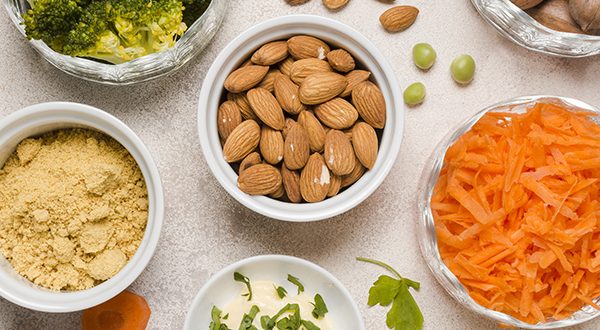 Astha Karkee
Astha Karkee
Co-founder & Nutritionist at Mitahara Nutritional Service, Astha is an experienced Clinical and Behavioral Nutritionist with over five years of expertise. She has served as a nutrition expert for the “FirstCry Fit Junior Project” in India and conducted research at Symbiosis University. Astha has published research papers on diverse topics, such as diabetes and foodborne pathogens. She strongly advocates for a holistic approach to health, recognizing the significance of nutrition as a fundamental pillar for both physical and mental well-being. Astha’s areas of specialization encompass child nutrition, nutrigenomics, and traditional nutrition practices.
In the past few years, there has been a growing inclination toward plant-based diets, including vegan diets, likely driven by their associated health benefits, environmental sustainability, and ethical considerations. However, there’s always a common concern about “whether we can get sufficient protein from plant-based foods,” and the good news is that a well-balanced vegetarian plan can exceed the required level as well. Therefore, you can easily maintain a high-protein diet without relying on animal-based food products.
Why is Protein Important?
Protein makes up 3/4th of the dry weight in most human tissues, excluding bone and fat tissue. This macro-nutrient helps in building and repairing tissue, supporting immune functions, maintaining muscle mass, hair, nails, and skin health, and is even important in the production of hormones and enzymes. The 20 amino acids are the basic building blocks of the protein, nine of which are considered essential because they cannot be synthesized by mammals in the required amounts. These amino acids (histidine, isoleucine, leucine, lysine, methionine, phenylalanine, threonine, tryptophan, and valine) obtained from the diet are required for most essential functions in the body. Therefore, it is important to have an adequate amount of protein to maintain a balanced diet.
The requirement of the protein (amino acids) varies among different age groups as the necessity keeps changing with the growth and development of the individual. Therefore, the amount to be included might vary in every individual depending on the age, health condition, and even gender. The Recommended Dietary Allowances (RDA) for protein is about 1.16 grams per kg body weight for infants to 0.8 grams per kg body weight for average adults, and 1.2-2 grams per kg body weight for active individuals. The amount varies depending on our health conditions and activity factors. For individuals with kidney conditions like CKD, we might have to maintain protein below 10% of the total calorie, a normal individual with less activity, the percentage is 16-18% of total calorie whereas for athletes or active individuals, the percentage can increase to 25-30%.
Diets like the keto diet and the carnivore diet, which heavily emphasize animal-based foods, often promote higher protein consumption than the Recommended Dietary Allowance (RDA). While this increased protein intake may be appropriate for individuals with high physical activity levels, intense training, or faster metabolisms, it is important to approach it carefully. Protein is essential for maintaining weight, supporting bone and hair health, and overall body function. However, consuming it in excess over time can place extra strain on the kidneys, as they are responsible for clearing byproducts of protein metabolism, such as urea. This added burden could potentially impact kidney health. Additionally, high protein intake raises the body’s water needs, as more fluids are required to flush out nitrogen waste, making hydration especially important. Beyond the risk of dehydration, an imbalanced diet high in protein but low in fiber can negatively affect gut health and digestion. Since diets like keto and carnivore are often high in saturated fats as well, it’s crucial to balance them with adequate fiber to support both digestive and heart health. For these reasons, increasing protein intake beyond the RDA should ideally be done under the supervision of a qualified expert.
Complementary proteins:
In general, animal proteins like eggs, meat products, and dairy are complete protein foods as they have all amino acids in adequate proportions. Incomplete protein sources have less of some essential amino acids, like most plant proteins, but incomplete doesn’t mean insufficient. When we combine two or more foods with incomplete proteins, they complement each other, providing all the essential amino acids. So, the complementary proteins are the plant-based food combinations that provide all the essential amino acids, which balance the deficiencies in individual sources. Therefore, it is important to follow the concept of complementary protein when we are opting for plant-based diets.
The common food combinations that form complete proteins are legumes with grains like rice and dal, dairy with nuts or grains, Bread and peanut butter, tofu with grains, yogurt with nuts, etc.
Plant-based Protein Sources
Below are the rich sources of plant-based proteins-
1. Soy products
Roasted soybean, tofu, soy milk, and edamame are complete proteins. Not only do they provide an adequate amount of protein, but they are also rich in omega-3 and calcium, which provide additional benefits to our body.
2. Beans and legumes
Lentils, chickpeas, and beans are fiber-rich sources of protein. They help in maintaining gut health as well.
3. Whole grains
Quinoa, millets, and buckwheat provide protein, fiber, as well as other nutrients. Among these, quinoa is also a complete protein.
4. Nuts and seeds
Almonds, Walnuts, flax seeds, chia seeds, and sunflower seeds not only provide us with healthy fats but also are high in protein, helping us to maintain a healthy weight.
In the past few years, there has been a growing inclination toward plant-based diets, including vegan diets, likely driven by their associated health benefits, environmental sustainability, and ethical considerations. However, there’s always a common concern about “whether we can get sufficient protein from plant-based foods,” and the good news is that a well-balanced vegetarian plan can exceed the required level as well. Therefore, you can easily maintain a high-protein diet without relying on animal-based food products.
Why is Protein Important?
Protein makes up 3/4th of the dry weight in most human tissues, excluding bone and fat tissue. This macro-nutrient helps in building and repairing tissue, supporting immune functions, maintaining muscle mass, hair, nails, and skin health, and is even important in the production of hormones and enzymes. The 20 amino acids are the basic building blocks of the protein, nine of which are considered essential because they cannot be synthesized by mammals in the required amounts. These amino acids (histidine, isoleucine, leucine, lysine, methionine, phenylalanine, threonine, tryptophan, and valine) obtained from the diet are required for most essential functions in the body. Therefore, it is important to have an adequate amount of protein to maintain a balanced diet.
The requirement of the protein (amino acids) varies among different age groups as the necessity keeps changing with the growth and development of the individual. Therefore, the amount to be included might vary in every individual depending on the age, health condition, and even gender. The Recommended Dietary Allowances (RDA) for protein is about 1.16 grams per kg body weight for infants to 0.8 grams per kg body weight for average adults, and 1.2-2 grams per kg body weight for active individuals. The amount varies depending on our health conditions and activity factors. For individuals with kidney conditions like CKD, we might have to maintain protein below 10% of the total calorie, a normal individual with less activity, the percentage is 16-18% of total calorie whereas for athletes or active individuals, the percentage can increase to 25-30%.
Diets like the keto diet and the carnivore diet, which heavily emphasize animal-based foods, often promote higher protein consumption than the Recommended Dietary Allowance (RDA). While this increased protein intake may be appropriate for individuals with high physical activity levels, intense training, or faster metabolisms, it is important to approach it carefully. Protein is essential for maintaining weight, supporting bone and hair health, and overall body function. However, consuming it in excess over time can place extra strain on the kidneys, as they are responsible for clearing byproducts of protein metabolism, such as urea. This added burden could potentially impact kidney health. Additionally, high protein intake raises the body’s water needs, as more fluids are required to flush out nitrogen waste, making hydration especially important. Beyond the risk of dehydration, an imbalanced diet high in protein but low in fiber can negatively affect gut health and digestion. Since diets like keto and carnivore are often high in saturated fats as well, it’s crucial to balance them with adequate fiber to support both digestive and heart health. For these reasons, increasing protein intake beyond the RDA should ideally be done under the supervision of a qualified expert.
Complementary proteins:
In general, animal proteins like eggs, meat products, and dairy are complete protein foods as they have all amino acids in adequate proportions. Incomplete protein sources have less of some essential amino acids, like most plant proteins, but incomplete doesn’t mean insufficient. When we combine two or more foods with incomplete proteins, they complement each other, providing all the essential amino acids. So, the complementary proteins are the plant-based food combinations that provide all the essential amino acids, which balance the deficiencies in individual sources. Therefore, it is important to follow the concept of complementary protein when we are opting for plant-based diets.
The common food combinations that form complete proteins are legumes with grains like rice and dal, dairy with nuts or grains, Bread and peanut butter, tofu with grains, yogurt with nuts, etc.
Tips to get enough protein
1. Include a variety of protein sources
You can combine the plant-based sources that complement each other to ensure complete protein intake. If possible, include soy products more frequently; however, in case of hypothyroidism, portion and frequency control are very important.
2. Try to include protein in every meal
Be mindful about the inclusion of protein sources in every meal (breakfast, lunch, snacks, dinner). Sometimes we tend to include grains with vegetable curry, which can easily compromise our overall protein intake for the day.
3. Plant-based protein powders/ bars.
You can prepare roasted soybean or pea-based protein powders, especially when you require options for post-workout meals. This will easily provide you adequate amount of protein for muscle recovery.
Although plant-based proteins can supply all the essential amino acids when different sources are combined thoughtfully, it is important to recognize that not all micronutrient needs can be fulfilled through plant foods alone. Vitamin B12 is one such nutrient that is primarily found in animal-derived products. Plant foods generally lack vitamin B12 unless they are specifically fortified, and in Nepal, access to fortified foods is quite limited. Therefore, individuals following a vegan diet who are at risk of vitamin B12 deficiency must rely on supplementation. Zinc is another essential nutrient that, while present in plant-based foods, tends to have reduced bioavailability because of phytates, compounds that inhibit its absorption. Nevertheless, a variety of plant foods — including legumes like beans, lentils, and chickpeas, as well as seeds such as sesame, pumpkin, and hemp — are good sources of zinc. Implementing food preparation techniques such as soaking, sprouting, or fermenting can further improve the absorption of zinc from these plant sources.
Sample plan for a day
Starting the day: Chia seeds or Flax seeds with water
Breakfast: Sourdough bread with peanut butter or Besan cheela/ gilo roti curd or soy milk
Lunch: Rice/ Quinoa/ Millet with any dal, seasonal vegetables, green leafy vegetables, and salads
Nuts and seeds: A Handful of almonds, walnuts, and mixed seeds, with seasonal fruit
Snacks: Roasted makhana with 1-2 spoons of roasted soybean
Dinner: Tofu, rice with mixed vegetables
Even for vegetarians, there are ample sources of plant-based proteins, so we can easily meet the required amount by proper planning, combination, and variation. With the proper vegetarian diet plan, we can achieve a healthy, nutritionally balanced body and prevent or manage health issues as well. The plants have you covered!
 Medicosnext
Medicosnext





